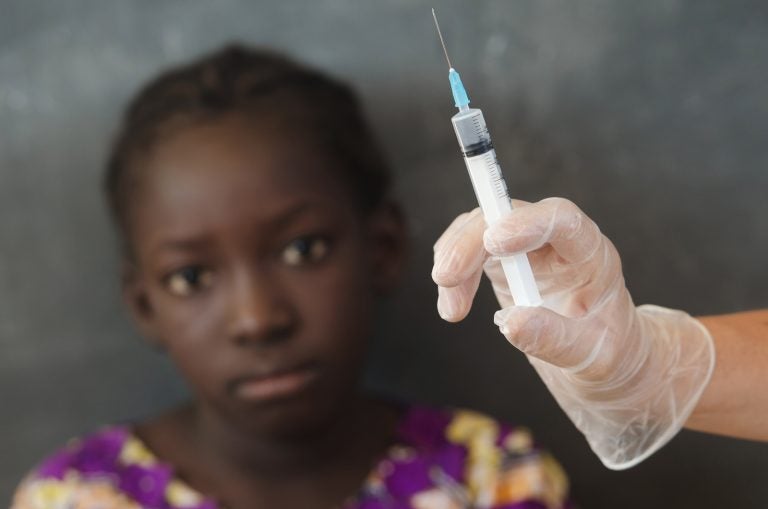Vaccines and schools — a public health power couple
School vaccination laws took a long time to take root. Today, every state has one. Here’s how that happened.
Listen 12:23
In all 50 states, children are required to receive certain vaccinations in order to attend public school. (Bigstock/borgogniels)
This story is from The Pulse, a weekly health and science podcast.
Subscribe on Apple Podcasts, Stitcher or wherever you get your podcasts.
Every school year, in all 50 states, parents have to prove their kids have received certain vaccines before enrolling them in school. Specific requirements differ from state to state, but the general rules is the same: no vaccines, no school.
It took more than a century for school vaccination laws to take root. And even today, public health officials and parents continue to puzzle over who and what they should cover.
The story of how schools became crucial cogs in the fight against contagious disease begins with the emergence of school itself. In 1852, Massachusetts became the first state to pass a compulsory education law: children had to go to school. Three years later, the Bay State required students to prove they’d been immunized against smallpox before enrolling.
For public health officials, the rationale behind these early rules was pretty simple. The growth of schools — especially in growing industrial cities — meant more and more kids clustered together for long parts of the day. The thinking: bustling classrooms created ideal conditions for a highly contagious disease like smallpox to spread.
“Kids are always more vulnerable to infectious diseases, and when you start to put more and more kids together in the same place it’s a natural response to say, well, we’re gonna require these kids to be vaccinated,” said James Colgrove, who studies public health history at the Columbia University’s Mailman School of Public Health.
But a century later, school vaccination laws remained the exception rather than the rule. By 1963, just 20 states had a vaccination mandate.
Scientists had developed several promising new vaccines in the post-war period, but many of the state laws only applied to smallpox.
Colgrove says states hesitated to establish mandates for a couple of reasons. For starters, many people were pretty enthusiastic about new vaccines such as the polio vaccine, and many volunteered their kids to receive the shots — if most people were complying, why make a rule? At the same time, public health officials feared a backlash if they forced parents to get their children immunized.
Those fears were rooted in more than a century of anti-vaccine sentiment, which bubbled up around the same time scientists developed the first, crude smallpox vaccines. Throughout the 1800s, vaccine skeptics and big-government critics waged legal battles against mandatory vaccine laws. Lower courts clashed on the constitutionality of these mandates, which led to a showdown in the U.S. Supreme Court.
In 1902, Cambridge, Massachusetts, responded to a smallpox outbreak by requiring all residents to receive the smallpox vaccine. Henning Jacobson, a Swedish immigrant and Lutheran minister, refused. He also refused to pay the $5 fine. Instead, his case went to court.
Scholars don’t know a ton about Jacobson, but it appears his opposition to vaccines wasn’t primarily related to his religion or his feelings about government.
“When the vaccinator came to his house, he said, ‘Well, several years ago one of my sons was vaccinated and he had a very bad reaction,’” Colgrove said. “‘And so for that reason I’m not willing to undergo this again.’”
Jacobson’s case reached the Supreme Court in 1905, and in a 7-2 decision the justices ruled the government did have the “police power” to compel vaccination. The minority judges didn’t rule a dissenting opinion, so historians don’t know why they opposed the ruling. But the majority felt, essentially, that the government had the right to protect the common good.
“The rationale was really that people who don’t want to be vaccinated can present a danger to the community,” Colgrove said.
But even with the courts on their side, states didn’t jump to institute new laws. That started to change in the 1960s, a decade when government was growing in size and aspiration. At the same time that Lyndon Johnson vowed to stamp out poverty with his “Great Society” reforms, public health officials started to talk about eradicating once-prevalent diseases like measles.
“Measles is extremely contagious, it spreads very rapidly in schools, and so the old rationale that we need to control these diseases in schools gets joined to a newer rationale which is, now maybe we can get rid of this disease forever,” Colgrove said.
Equity-minded reformers also see school-based laws as a good way to ensure that all children — poor and well-to-do — are protected against disease.
“If you want to target all kids equally, a natural place to do that is in schools, [because] all kids go to school,” Colgrove said.
In the late 1960s and early 1970s, states started to adopt more school-based vaccination laws.
In 1970 Alaska passed a law requiring that all students be immunized against diphtheria, tetanus, measles, rubella, and tetanus. But it didn’t ensure high coverage rates, as a young medical resident named John P. Middaugh was about to find out.
Middaugh was a minister’s son from Baltimore with an appetite for adventure. In his 20s he’d ridden motorcycles across the Canadian Rockies and worked in medical clinics in rural Ethiopia. In 1975, when he was 27, he landed a position working at a cholera lab in Bangladesh run by the Centers for Disease Control. When a coup toppled Bangladesh’s leader, Middaugh wound up looking for another job.
The CDC offered him a two-year gig as the acting epidemiologist in Alaska, a post that intrigued the fiddle-footed doctor.
“I just thought, wow, I’ve always wanted to see Alaska, and here’s a chance to go up there for two years,” said Middaugh. “So I’ll get to see the state. I’ll have an adventure.”
Alaska was young, wild, and growing, thanks to the recent infusion of oil money. Middaugh remembers a pervasive sense of optimism and possibility.
“The attitude was, gosh, if you have an idea of how to approach these things, let’s go try it and see if it will make a difference,” he said.
That pioneer spirit was tested in the fall of 1976, when a measles outbreak in Anchorage quickly spread throughout the state. Middaugh and his colleagues were initially confused. Hadn’t the state just passed a law requiring measles shots?
They started visiting schools to investigate.
“And in this first array of schools that we went to they virtually didn’t have any immunization records,” Middaugh recalled. “And the ones that they did have were very incomplete.”
Schools weren’t following the law. “We identified, out of about 100,000 students in the state, about 30,000 that were missing some of the vaccines,” Middaugh said.
He and his colleagues had an idea that, remarkably, hadn’t really been tried before. They said, let’s actually enforce the law. Or, to put it more bluntly, kick non-complying kids out of school.
Middaugh called his boss at the CDC to tell him the plan.
“And the first comment was that, ‘Well, you’ll never be able to do that,’” Middaugh said with a chuckle. “And I said, ‘Why not?’ And he said, ‘Well, people won’t support enforcing that.’”
But Middaugh thought those optimistic Alaskans would get behind their government. And so state officials set a deadline. Any student who couldn’t prove he or she had been immunized against the measles would be sent home.
On the first day of enforcement, just over 8 percent of all Alaskan students were banned from attending schools. But within weeks, nearly all the stragglers received their shots, and the outbreak ceased. The big public outcry health officials feared never materialized.
Later that same year, Los Angeles discovered a similar phenomenon during its own measles outbreak and responded the same way — by actually enforcing the law. Again, coverage rates skyrocketed.
The experiments in Alaska and Los Angeles proved to public health experts that tough laws coupled with real enforcement could greatly reduce the number of unvaccinated kids. From there, the modern era of school vaccination law took off.
“Others rapidly saw that the public was way more supportive of trying to protect kids against vaccine-preventable diseases than anybody had suspected,” Middaugh said.
Emboldened by the success, the CDC partnered with First Lady Rosalynn Carter and former Arkansas First Lady Betty Bumpers on a campaign to expand and enforce vaccination laws. By 1980, all 50 states required kids get at least some vaccines before entering school.
In the beginning these school-based laws were supposed to stop the spread of disease among children. But some might say public health officials got a little greedy. They saw how effective these laws were and started targeting diseases that don’t typically spread among kids, diseases like Hepatitis B.
“A lot of parents, I think, that kind of prejudices them against the whole vaccine schedule,” said Alison Buttenheim, a researcher at the University of Pennsylvania who studies the effectiveness of vaccines laws. “‘You’re gonna vaccinate my newborn baby, today, for a sexually transmitted disease that I don’t have and I don’t expect this kid to be exposed to for a very long time? W-T-F?’”
You can feel that sense of W-T-F in the modern anti-vaccine movement, which includes some doctors who advocate for alternative vaccine schedules or simply fewer shots.Today as states consider tweaking their vaccine laws, they have to account for those skeptics in their political and practical calculus.
In 2015, California lawmakers responded to a measles outbreak by getting tougher. For years, the state let parents opt their kids out of vaccines if they had a religious or philosophical objection. California removed those exemptions in 2015. Today, if you’re trying to avoid getting your kid vaccinated, you have to provide a medical reason.
Buttenheim is studying the fallout. She’s not yet sure if the change really worked, or just made people angrier. She thinks states might be better off letting parent claim religious or personal-belief exemptions, but making those exemptions harder to get.
“If you have to get something notarized, that may be just enough of a hassle factor that it’s just easier to go get the kid vaccinated and bring the records in to school,” Buttenheim said.
It took a long time for states to get really serious about school vaccination laws. Then they got really serious, really quickly.
Now we’re in a moment again where public health experts are wondering how far they can go before hurting their own cause.
WHYY is your source for fact-based, in-depth journalism and information. As a nonprofit organization, we rely on financial support from readers like you. Please give today.







